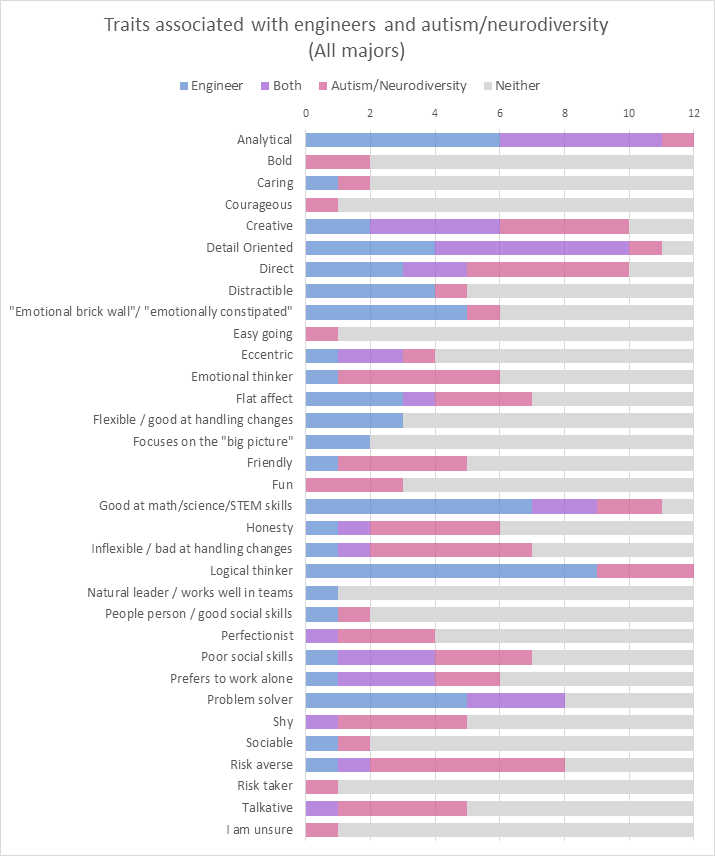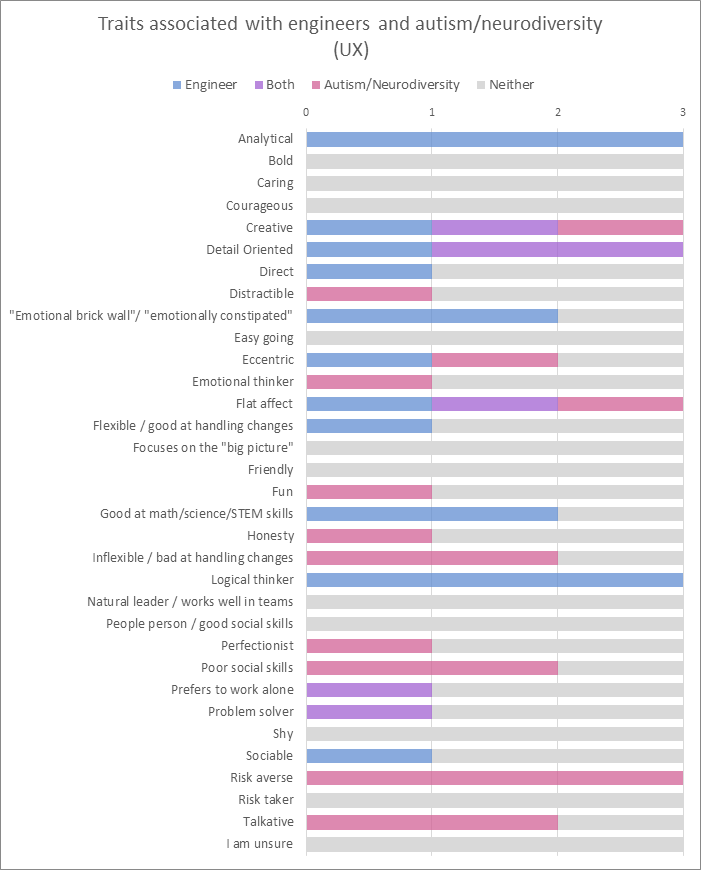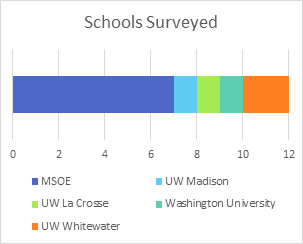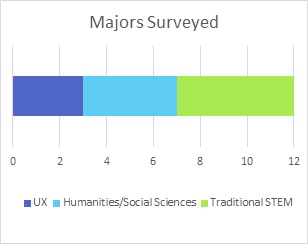Portfolio ⮞ Survey Project
Survey Project
Project Overview
UXD 3010 UX Research
Independent Project
October 2023 | 2-3 Weeks
In my Fall 2024 UX Research Class, I independently conducted a survey to learn about a topic of my choice. I identified what I wanted to learn about, wrote focused survey questions, sent out the survey, and analyzed the results.
Project Goal
The goal of my survey was to compare and contrast traits that people might identify with engineering and autism to see if they would overlap. I surveyed 12 students from 5 different universities in addition to a mix of students with traditional STEM majors or humanities majors.
Personal Contributions
I completed the following key tasks:
- Identified topic and audience: I thought of something that I could make a survey about and that I would be able to send out and receive responses within the timeframe I was given.
- Wrote survey questions: I followed questionnaire design practices to write easily understood questions and provided various multiple-choice responses to allow for participants to respond how they feel comfortable without forcing them to lie.
- Created visuals: I exported the raw survey responses and formatted them in Microsoft Excel. I coded the responses to make understanding the data a bit easier and to create different visualizations to aid with the analysis.
- Reported findings: I analyzed the responses and created a findings report, noting the majority results as well as an interesting finding.
Project Results
My inclusion of custom created data visualizations was noted, as the other students in my class did not create their own visualizations. My professor noted that my graphs were a bit difficult to read because there was so much information on there, but added that I had not taken the Data Visualization class yet.
Report
Table of Contents
Introduction
The goal of this survey was to compare and contrast traits that people associate with engineers and autism/neurodiversity. I asked the participants what they’re majoring in, their knowledge about autism/neurodiversity, and their satisfaction of their school’s awareness of autism/neurodiversity.
The focus of the survey was really about comparing traits of autistics and engineers, but I included neurodiversity as a whole because that term includes autism and ADHD, which can be very similar to how autism presents.
I realized that I completely forgot to have a survey question about whether the participant was neurodivergent in my actual survey. I had one in my planning document, but I was having trouble in SurveyMonkey and I missed the question. That would have allowed me to compare what participants who were neurodivergent said against neurotypical participants.
I asked participants to select the traits they associated with engineers first, then asked them to select the traits they associate with autism/neurodiversity. I thought that having the participants do this separately would reduce bias.
It was a bit difficult to determine what graphs to use to visually represent the data I collected (other than the traits). I decided to go with the same stacked bar for every question to be consistent. I think my color choice for the traits graphs was wise, because to show the overlap between what people associate the traits with I used purple, which is a combination of the colors I used to represent engineers and autistics.
Top Analyses
There 4 very tall charts for this section. You can click on each image to view it in a new tab to view them easier.
Findings Report
The majority of participants associate being analytical, detail-oriented, good at math/science/STEM skills, and a logical think with engineers. The slight majority of participants associate being creative, direct, detail-oriented, and risk-averse with autism/neurodiversity. Traits that participants don’t tend associate with either engineers or autism include being courageous, easy-going, natural leader, good social skills, sociable, and risk-taker.
The majority of traditional STEM majors generally followed the trends of all majors, but STEM majors tended to mostly associate certain traits with engineers rather than engineers and autistics or autistics alone. This contrasts against the HU/SS participants associated. These participants tended to mostly associate certain traits with autistics, and the combination of autistics and engineers, rather than engineers alone.
The knowledge of autism/neurodiversity among the participants appeared to follow a normal distribution, where the majority of participants reported either a ‘passible amount of knowledge’ or ‘not very knowledgeable’, leaving one response each for ‘very knowledgeable’ and ‘I feel like I know nothing’.
The majority of participants were dissatisfied or slightly dissatisfied with the level of autism/neurodiversity awareness at their school, with the remainder being indifferent.
One participant associated an assortment of traits with engineers, and was unsure of what they associated with autistics. This participant reported their knowledge about autism/neurodiversity as ‘I feel like I know nothing’, which goes in line with what they reported for autistic traits. But then they reported that they were neither satisfied nor dissatisfied with the level of autism/neurodiversity awareness at their school. Meaning that that participant doesn’t know anything/is unsure about autism but doesn’t seem to mind the current awareness level at their school.





